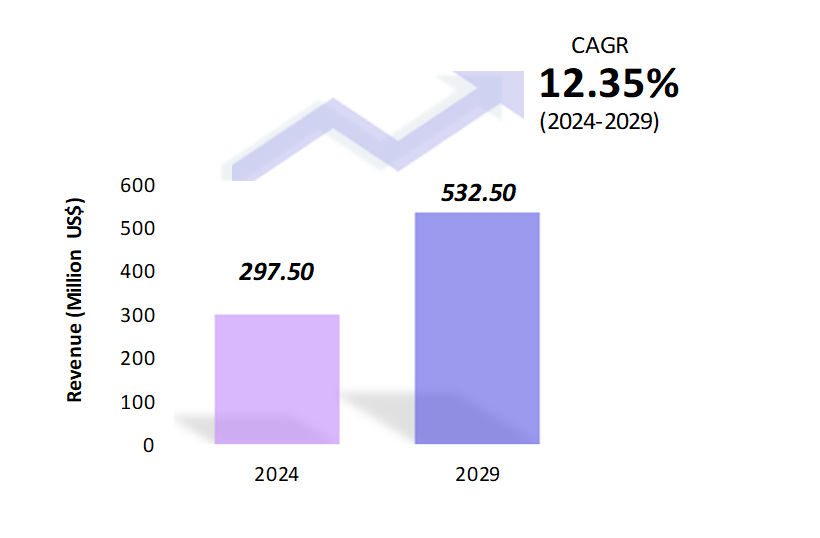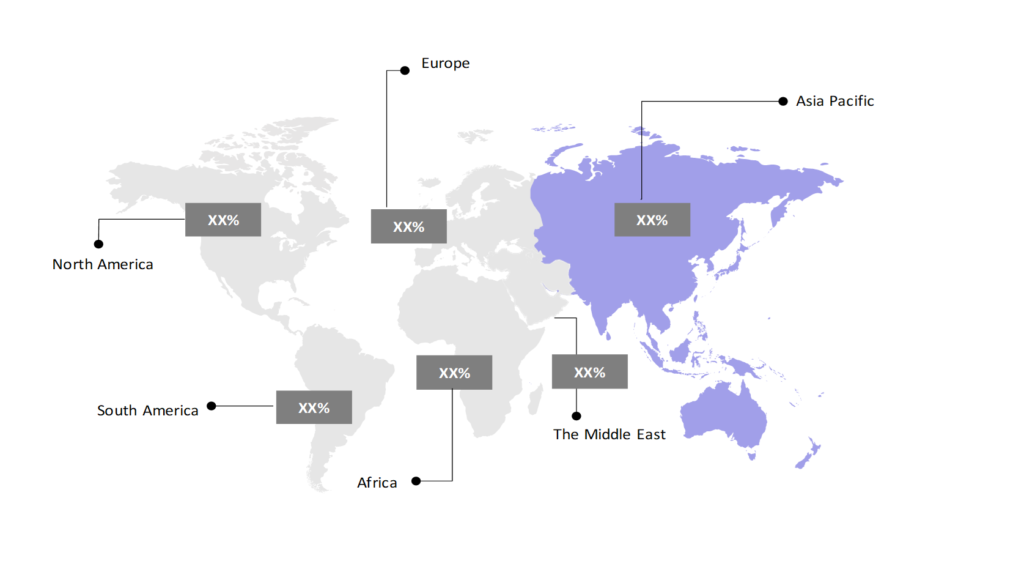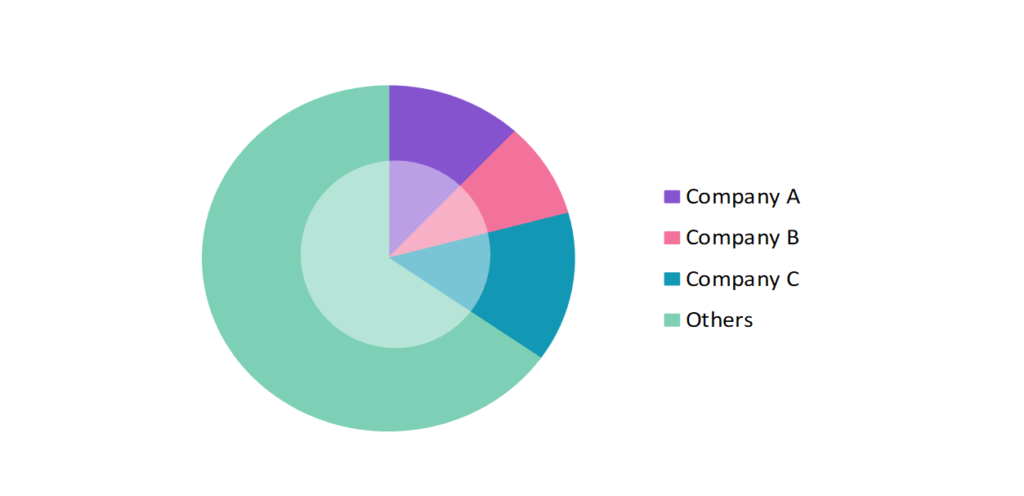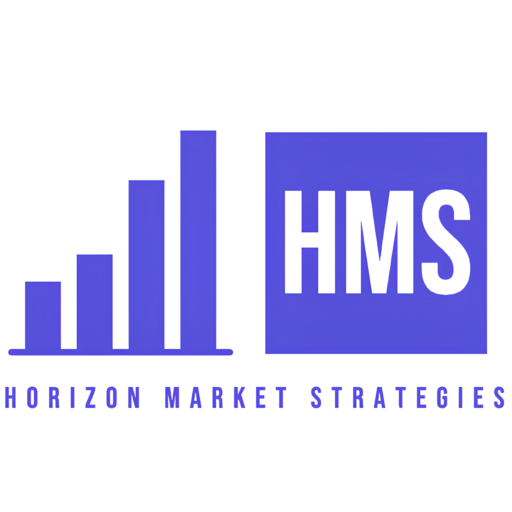Blood Bags Market Analysis: Growth, Size, Share & Future Trends (2024-2029)
The report covers a comprehensive analysis segmented by Type (Single blood bag, Double blood bag, Triple blood bag, Quadruple blood bag, Penta blood bag), By Material (PET, PVC, Others), By Volume (100, 200, 250, 400, 500), By End User (Blood banks, Hospitals, Clinical research, Diagnostic center, Ambulance Surgical center, Others), By Geography (North America, South America, Asia Pacific, Europe, the Middle East, Africa)
Blood Bags Market Snapshot

Blood Bags Market Overview
The market for blood bags is expected to grow from its estimated $297.5 million in 2024 to $532.5 million in 2029. For the projection period of 2024–2029, the worldwide blood bag market is growing at a compound annual growth rate of 12.35%. The healthcare business relies heavily on the blood bag market to make blood collection, storage, and transfusion processes easier. Technological developments, changing demographics, and increased healthcare needs are some of the drivers propelling the market’s constant expansion.
Concurrently, there is a growing emphasis on sustainability within the industry, prompting manufacturers to explore eco-friendly materials and production processes. Innovations in blood bag design and materials have focused on enhancing safety, reducing contamination risks, and improving storage conditions for blood components. Innovations in blood bag design and materials have been significantly influencing market growth. Manufacturers are focusing on developing safer, more efficient blood bags that can minimize the risk of contamination, reduce transfusion-related complications, and improve storage conditions for blood components. This includes the use of PVC-free materials, advanced sterilization techniques, and improved storage solutions. Single-use systems in blood bag technology offer enhanced convenience, efficiency, and infection control in blood collection, processing, and transfusion procedures.
As healthcare systems throughout the world work to fulfill the rising demand for blood products while addressing environmental concerns and guaranteeing patient safety, the blood bag industry offers tremendous potential for growth and innovation. For the blood bag market to survive and grow in the future, cooperation between regulatory agencies and industry players will be crucial.
Blood Bags Market Coverage
| Historical & Forecast Period | 2018-2029 |
| Base Year | 2023 |
| Forecast Period | 2024-2029 |
| Units | Billion US$ |
| Segments | Type, Material, Volume, End User |
| Geographies | North America, South America, Asia Pacific, Europe & Middle East, Africa |
| Key Vendors | Terumo Corp., Grifols, S.A., Maco Pharma International GmbH, Haemonetics Corp., BMS Group. |
Key Geographies of Blood Bags Market, 2023

Porter’s 5 Forces Analysis of Blood Bags Market

Blood Bags Market Trends
Blood transfusions are becoming increasingly necessary in emerging nations, where there is a growing demand for blood bags due to the expansion of healthcare infrastructure. Environmental concerns have led to a growing emphasis on sustainability within the healthcare industry, including the blood bag market. To lessen the environmental impact of producing and disposing of blood bags, manufacturers are looking into environmentally friendly materials and production techniques. Blood bags are utilized in many aspects of healthcare, such as blood component therapy, transfusions, and blood collection for examination and testing. The demand for blood bags has been steadily increasing due to rising healthcare needs globally. This need is influenced by several factors, including an aging population, a rise in prevalence of chronic diseases, and an increase in procedures that need blood transfusions. Innovations in blood bag design and materials have significant trends. Blood component storage conditions are being improved, transfusion-related issues are being avoided, and manufacturers are concentrating on creating safer, more effective blood bags.
The use of PVC-free materials and improved sterilization techniques enhance the safety and quality of the blood bags, leading to better patient outcomes. The market is expected to benefit from the expansion of the healthcare industry and the rising number of hospitals and clinics being built. A shift is seen towards single-use systems as it also offers convenience and efficiency in blood collection, processing, and transfusion procedures. It is essential to guarantee the safety of blood products throughout the transfusion process. Ensuring product safety and efficacy remains a top priority for companies in the blood bag market. This includes implementing measures to prevent contamination, ensuring proper storage and transportation conditions, and adopting technologies for blood screening and testing. This is done to minimize the risk of transfusion-transmitted infections.
Blood Bags Market Driving Factors
Increasing globalization and international trade in blood products have created opportunities for blood bag manufacturers to tap into new markets and expand their geographical reach. Cross-border collaborations, partnerships, and strategic alliances facilitate the exchange of blood products between regions, driving demand for standardized, compatible blood bags and fostering market growth. The expansion of healthcare facilities, coupled with government initiatives to improve blood donation rates and transfusion services, has fueled the demand for blood bags and related products, driving market growth. Chronic diseases such as anemia, cancer, and blood disorders, coupled with the growing number of surgical procedures worldwide, have boosted the demand for blood transfusions.
The market is expected to develop because of blood bags’ reputation as a safer option for the transfusion, storage, and transportation of blood and blood components. Blood transfusion techniques are made safer, more reliable, and efficient by regularly monitoring blood bag designs, materials, and manufacturing processes and making the necessary changes. Regular developments are developed to increase the quality of blood products, such as integrated leukoreduction filters and single-use disposable blood bags. These creative aspects are also found to limit the risk of contamination, which helps to expand the market.
Heightened awareness regarding blood safety, transfusion-transmitted infections mandate the use of blood bags that meet specific safety and performance criteria, driving market growth. The elderly group requires regular medical interventions and blood transfusions, leading to an increase in the demand for blood bags. Additionally, initiatives to increase the number of blood donors via public awareness campaigns, mobile blood drives, and incentives for voluntary blood donation increase the supply of blood products and spur market expansion.
Blood Bags Market Challenges
The blood bag market faces various challenges despite its growth trajectory. One significant challenge is ensuring the availability of a safe and adequate blood supply to meet the increasing demand. In emerging markets with expanding healthcare infrastructures hurdles in blood collection, storage, and distribution can lead to shortages and inefficiencies in meeting demand. Maintaining the quality and safety of blood products throughout the supply chain poses significant challenges, including risks of contamination and adherence to stringent regulatory standards.
The need to provide environmentally friendly materials and disposal techniques for blood bags to reduce their negative effects on the environment is another difficulty. Additionally, the COVID-19 pandemic has further impacted the blood bank resources, disrupted donation patterns, and highlighted the vulnerability of the blood supply chain to external shocks.
Furthermore, there are challenges related to technological advancements and innovation. While there is a push for safer and more efficient blood bags, integrating innovative technologies and materials into production processes can be costly and time-consuming. Addressing these challenges requires collaborative efforts among healthcare providers, policymakers, industry stakeholders, and regulatory bodies to implement innovative solutions and improve infrastructure.
Blood Bags Market – Key Industry News
- In May 2023, The Indian Council of Medical Research (ICMR) successfully launched iDrone initiative for delivery of blood bags by drones.
- In July 2023, Public Minister of Egypt discussed the establishment of a factory, the first of its kind in Egypt, to produce blood bags, anticoagulants, and supplies used in blood transfusions for patients.
- In February 2024, Xheme Inc., and Vitalant Research Institute (VRI), the nation’s second largest blood services provider, jointly are developing a non-toxic, non-PVC film technology that ensures to conserve scarce blood supplies and meets upcoming European Union regulatory requirements for medical plastics.
Blood Bags Market Competitive Landscape
The competitive scenario of the blood bag market is characterized by key players striving to enhance product safety, efficiency, and affordability amidst growing demand. Strategies focus on maintaining blood safety during transfusion, ensuring precise temperature control of blood bags, and complying with regulatory standards for quality assurance. The participants in the global blood bags industry are always developing their strategies to preserve a competitive advantage. Companies primarily use acquisitions, R&D, partnerships, and technological launches. Several important entities in the blood bags market include Terumo Corp., Grifols, S.A., Maco Pharma International GmbH, Haemonetics Corp., BMS Group, and others.
Blood Bags Market Company Share Analysis, 2023 (%)

Blood Bags Market – Key Companies

Reason to Buy from us

Table of Contents
| 1. Introduction | 1.1. Research Methodology 1.2. Scope of the Study |
| 2. Market Overview / Executive Summary | 2.1. Global Blood bags Market (2018 – 2022) 2.2. Global Blood bags Market (2023 – 2029) |
| 3. Market Segmentation | 3.1. Global Blood bags Market by Type 3.1.1. Single blood bag 3.1.2. Double blood bag 3.1.3. Triple blood bag 3.1.4. Quadruple blood bag 3.1.5. Penta blood bag 3.2. Global Blood bags Market by Material 3.2.1. PET 3.2.2. PVC 3.2.3. Others 3.3. Global Blood bags Market by Volume 3.3.1. 100 3.3.2. 200 3.3.3. 250 3.3.4. 400 3.3.5. 500 3.4. Global Blood bags Market by End User 3.4.1. Blood banks 3.4.2. Hospitals 3.4.3. Clinical research 3.4.4. Diagnostic centre 3.4.5. Ambulance Surgical centre 3.4.6. Others |
| 4. Regional Segmentation | 4.1. North America 4.1.1. The U.S. 4.1.2. Canada 4.1.3. Mexico 4.2. South America 4.2.1. Brazil 4.2.2. Argentina 4.2.3. Colombia 4.2.4. Chile 4.2.5. Rest of South America 4.3. Asia Pacific 4.3.1. China 4.3.2. India 4.3.3. Japan 4.3.4. South Korea 4.3.5. Rest of Asia Pacific 4.4. Europe 4.4.1. UK 4.4.2. Germany 4.4.3. Italy 4.4.4. France 4.4.5. Spain 4.4.6. Rest of Europe 4.5. The Middle East 4.5.1. Turkey 4.5.2. UAE 4.5.3. Saudi Arabia 4.5.4. Rest of the Middle East 4.6. Africa 4.6.1. Egypt 4.6.2. South Africa 4.6.3. Rest of Africa |
| 5. Value Chain Analysis of the Global Blood bags Market | |
| 6. Porter Five Forces Analysis | 6.1. Threats of New Entrants 6.2. Threats of Substitutes 6.3. Bargaining Power of Buyers 6.4. Bargaining Power of Suppliers 6.5. Competition in the Industry |
| 7. Trends, Drivers and Challenges Analysis | 7.1. Market Trends 7.1.1. Market Trend 1 7.1.2. Market Trend 2 7.1.3. Market Trend 3 7.1.4. Market Trend 4 7.1.5. Market Trend 5 7.2. Market Drivers 7.2.1. Market Driver 1 7.2.2. Market Driver 2 7.2.3. Market Driver 3 7.2.4. Market Driver 4 7.2.5. Market Driver 5 7.3. Market Challenges 7.3.1. Market Challenge 1 7.3.2. Market Challenge 2 7.3.3. Market Challenge 3 7.3.4. Market Challenge 4 7.3.5. Market Challenge 5 |
| 8. Regulatory Landscape | |
| 9. Competitive Landscape | 9.1. Terumo Corp. 9.2. Grifols, S.A. 9.3. Maco Pharma International GmbH 9.4. Haemonetics Corp. 9.5. BMS Group 9.6. Company 6 9.7. Company 7 9.8. Company 8 9.9. Company 9 9.10. Company 10 |
Blood Bags Market – Frequently Asked Questions (FAQs)
What is the current size of the global blood bags market?
The market size for the global blood bags market in 2024 is $297.5 Mn.
Who are the major vendors in the global blood bags market?
The major vendors in the global blood bags market are Terumo Corp., Grifols, S.A., Maco Pharma International GmbH, Haemonetics Corp., BMS Group.
Which segments are covered under the global blood bags market segments analysis?
This report offers in-depth insights into each type, material, volume, end user.
